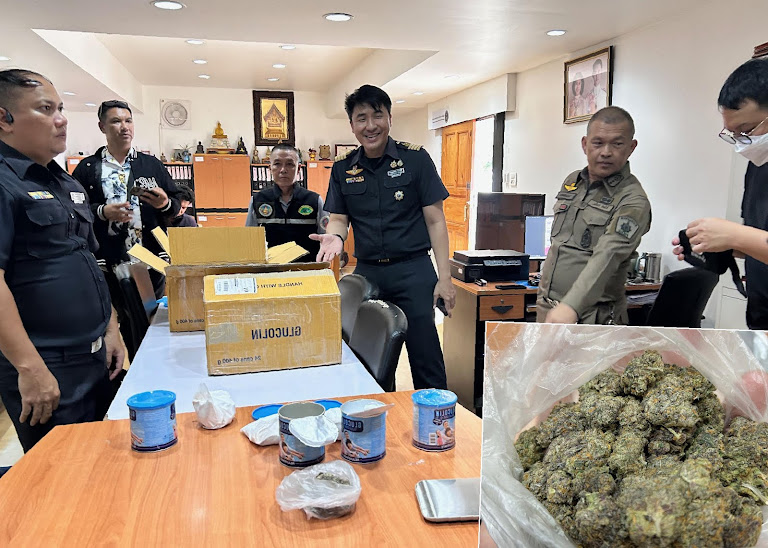Nong Khai’s Cannabis Candy Exposes Flaws in Global Drug War
Candy bust reveals how smugglers exploit legalization loopholes, fueling a global game of cannabis cat-and-mouse.

A few cans of glucose powder, concealing a few bags of cannabis buds, intercepted on their way to Laos. It seems small, almost comical. But hidden in this seemingly insignificant incident in Nong Khai, reported by Khaosod, lies a microcosm of the evolving, complex, and often contradictory global drug trade, particularly in a post-cannabis control environment. More than that, it’s a Rorschach test for our deepest assumptions about the efficacy of regulation, the unintended consequences of liberalization, and the stubborn resilience of markets, legal or otherwise.
The very act of attempting to disguise cannabis within a seemingly innocuous product points to the ingenuity, yes, but more importantly, the rationality of those involved in the illicit drug trade. They’re not operating in a vacuum; they’re exploiting the seams and fractures created by shifting legal frameworks, seeking arbitrage opportunities in a world where cannabis legality varies wildly across borders — a direct consequence of the uneven, often contradictory, global cannabis policy landscape. Lieutenant Colonel Jirawit rightly notes that “Following cannabis control announcements, there may be increased attempts to smuggle cannabis in and out of the country." This isn’t just adaptation; it’s a calculated response to policy-induced price differentials.
'Police have seized the cannabis and will proceed according to legal procedures.”
But let’s zoom out. For decades, the dominant narrative has been of a relentless “War on Drugs,” a globally coordinated effort to suppress the production, distribution, and consumption of illicit substances. This approach, spearheaded by the Nixon administration and sustained through successive presidencies, led to mass incarceration — particularly impacting minority communities — destabilized regions like Colombia and Afghanistan, and fueled unimaginable violence. We are only now, haltingly, beginning to reckon with the scale of that devastation, and to see a slow, uneven retreat from that paradigm, with pockets of legalization and decriminalization emerging worldwide.
The Thai government’s shifting stance on cannabis, while initially appearing progressive, has been fraught with challenges. The initial deregulation, followed by stricter controls implemented due to a lack of a robust regulatory framework, created a confusing regulatory environment, ripe for exploitation. It’s not unlike the Dutch experience, where “coffee shops” exist in a legal gray area, often supplied by a criminal underworld, or even California’s struggle to effectively regulate its legal cannabis market and undercut the illicit trade. We have to acknowledge that liberalizing cannabis laws doesn’t automatically eliminate the black market; it merely reconfigures it, often driving innovation in smuggling and distribution.
This shift highlights the crucial distinction between decriminalization and legalization. Decriminalization reduces penalties for possession, while legalization establishes a regulated market, ideally one that addresses not only supply but also consumer safety, taxation, and distribution controls. The former can lead to uncertainty and ongoing criminal activity, while the latter requires careful consideration of factors like taxation, licensing, and public health. As Professor Peter Reuter at the University of Maryland, a leading expert on drug policy, has argued, “Good drug policy requires both harm reduction and market regulation.” He’s also emphasized the need to anticipate unintended consequences, which often arise when policy lags behind market realities. Without that, we get the situation in Nong Khai — a fertile ground for opportunistic smuggling.
Ultimately, the glucose-cannabis cocktail in Nong Khai forces us to confront the uncomfortable truth that the war on drugs didn’t disappear; it simply shape-shifted. The players adapted, often becoming more sophisticated. The methods evolved, leveraging globalization and technological advancements. The inequities persist, with the most vulnerable populations often bearing the brunt of both prohibition and poorly designed legalization efforts. And until we grapple with the complex economic and social forces driving both supply and demand, acknowledging the powerful role of addiction, poverty, and lack of opportunity, we’ll continue to see these small, telling stories unfolding at border crossings around the world. This isn’t a victory lap; it’s a signal to examine the full systemic impact of our policies, and to ask ourselves not just what we intended to achieve, but what we actually are achieving.









